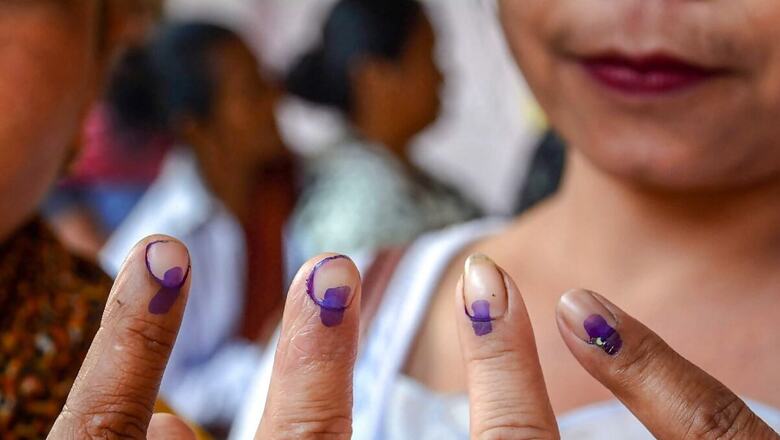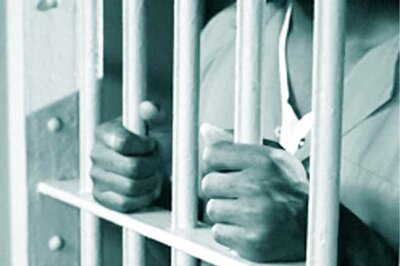
views
Shrawasti is one of the 80 Lok Sabha constituencies in Uttar Pradesh and comes under the general category. The seat covers the entire Shrawasti district and part of Balrampur district. It consists of five assembly segments: Bhinga and Shrawasti in Shrawasti district, and Tulsipur, Gainsari, and Balrampur (SC) in Balrampur district.
Ram Shiromani Verma won the seat on a Bahujan Samaj Party ticket in 2019, but he is the Samajwadi Party’s candidate this time after a switch, while Saket Misra of the Bharatiya Janata Party is the other key contender.
Polling will take place in Shrawasti on May 25 in the sixth and penultimate phase of the ongoing general elections, with the votes to be counted on June 4.
Political dynamics
BJP in Pole Position: In Shrawasti, the BJP has nominated Saket Misra, who appears to have a clear edge against the SP’s Ram Shiromani who is the incumbent MP, having won the seat in 2019 with a BSP ticket by a razor-thin margin of 5,320 votes.
Saket Misra is a former IPS officer, who later worked as an investment banker in Singapore for several years. He is currently a Member of the Legislative Council (MLC) and has been working for years in the constituency. Misra’s work during the Covid pandemic and engagement with constituents has earned him recognition and goodwill in Shrawasti, which will be leveraged this election. Misra has vowed to pull the region out of backwardness if he is elected.
Moreover, he is the son of Nripendra Misra, chairman of the Shri Ram Janmabhoomi temple construction committee and a former principal secretary to Prime Minister Narendra Modi. Nripendra Misra served as the principal secretary from 2014 to 2019 before unexpectedly resigning in August 2019. In January 2020, he was appointed chairman of the executive council of the Nehru Memorial Museum and Library. Subsequently, in February 2020, he was elected chairman of the temple construction committee of the Shri Ram Janmabhoomi Teerth Kshetra Trust.
There are several factors that are at play here, which indicate the plausibility of a BJP victory in this seat. First, anti-incumbency against MP Ram Shiromani is high. Second, the caste equations are favouring the BJP, especially in the absence of a BSP-SP alliance. Third, the increasing approval for the Narendra Modi-Yogi Adityanath double-engine government in Shrawasti. Moreover, the party is backed by three MLAs who have bolstered its campaign.
While Misra has been visible in the constituency for the last few years, his opponent has not been around as much despite being the MP. An industrialist, Shiromani is facing anger for being “absent” and inaccessible, with no major highlight of his performance as an MP in the last five years.
When it comes to caste arithmetic, Shrawasti has a large number of voters from the Verma community who are often pivotal kingmakers during elections. While the Verma community in 2019 swung in favour of Shiromani, a sense of discontentment against the MP has crept in even among them. Vermas account for about 12% of the voter population and are expected to split in favour of the BJP. Meanwhile, Brahmin (10%), Rajput (8%), and Vaishya (5%) are expected to lean strongly towards the BJP. Another interesting observation relayed from the ground is that Yadav voters stand significantly disillusioned with the SP in this part of Uttar Pradesh, leaning partly towards the BJP and preventing a consolidation of Yadav votes for the SP. Moreover, Dalit and OBC votes, are expected to back the BJP as well, making for favourable conditions for the party. Also, in the absence of an alliance with the BSP, the SP is challenged with a probable division of anti-BJP votes, which may prove detrimental in a close contest.
The Modi-Yogi double-engine factor is also at a high point in this constituency. While law and order has improved, the BJP is also credited with a slew of development work that has taken place in the constituency. Welfare schemes such as Garib Kalyan Yojana, which involves free ration for the poor, Awas Yojana, Ayushman Bharat, and Kisan Samman Nidhi, have all contributed to pro-Modi sentiments among voters. Chief minister Yogi Adityanath, meanwhile, has a connection with voters here, as the Balrampur assembly segment is often touted as his second home. He makes frequent visits to Balrampur to the Devi Patan Mandir and has provided funds for development work on the temple premises.
The SP’s Challenge: The Samajwadi Party has nominated incumbent MP Ram Shiromani to contest for a second term. Shiromani faces intense anti-incumbency as the industrialist is accused of not spending time in the constituency and remaining in Ambedkar Nagar where he is originally from. Aware of the “outsider” tag, he says that he has recently constructed a luxurious mansion in Katra, Shrawasti, to avoid being labelled an outsider. Verma has since left both the BSP and Ambedkar Nagar.
However, it is going to be an uphill task for the leader to woo disillusioned constituents in the midst of the rising popularity of the BJP and a formidable rival in the form of Saket Misra.
This concern is further exacerbated by the fact that Shiromani won the seat in 2019 with a very slim margin of 5,320 votes backed by the SP-BSP alliance, which is no longer in play in 2024. With the BSP going its own way, a division of votes is expected, and the equations have heavily tilted against the leader.
Moreover, the caste equations are also not forming up favourably, with both Verma and Yadav voters reportedly feeling disillusioned with the incumbent MP. Further, the SP here is not in great shape even among the massive Muslim electorate, which stands at about 34%. A lack of enthusiasm owing to a lacklustre candidate is to blame, which may lead to low voter turnout. Ultimately, if consolidation of the traditional vote banks fails to take place, the SP-Congress alliance could be in trouble this time. The Congress, meanwhile, is a minor player, scoring less than 6% of the vote share in 2019, but may make a considerable difference in the case of a tight contest.
Relying on the Akhilesh Yadav factor is the party’s last resort. However, Yadav has not been campaigning aggressively here and his magnetism in this Lok Sabha election has waned in Shrawasti as per observers on the ground.
All in all, while the SP relies on caste equations and two of its MLAs in the constituency, the BJP commands an edge and may sail through with a victory.
Voter demographics
- Total voters (2019): 19,14,441
- Urban: 6.4%
- Rural: 93.6%
- Literacy: 39.41%
- SC: 14.6%
- ST: 1.1%
- Hindu: ~65%
- Muslim: 34.83%
Key issues
Civic Infrastructure: Road connectivity has improved in Shrawasti and flood-proof infrastructure has been constructed along with embankments. However, there are some regions in the constituency which still suffer, especially rural areas such as Jamunaha. Health infrastructure is lagging in the region. It does not even meet the required number of primary health centres (PHCs). The region has a population of 1.1 million people and has just 11 PHCs, i.e., 100,000 people per centre, as opposed to the government-recommended 30,000 people per centre. Even those that do exist are in poor condition. There is an absence of specialist staff and doctors at a majority of these centres. The lack of primary healthcare means that diseases that could have been prevented or treated at the primary level end up overburdening tertiary care centres.
Electricity Supply: While the government had ensured 24-hour electricity supply in the region, that has not remained the case. Damages caused by strong winds and even neglect by the local administration have ensured that there are certain breakages in the electricity supply in the region. One such incident was reported this year in the Pipri village of Gilola. An electric pole outside the village had broken and fallen due to a storm. Because of this, the power supply was disrupted for more than 20 days. What was more surprising was the utter laxity of the local administrative body for its failure to repair or replace the pole to ensure that the electricity supply restarts to the village which has around 40 households.
Poverty: Poverty is a major challenge in Shrawasti. The region bordering Nepal is among the poorest in India. The NITI Aayog report on multi-dimensional poverty in 2015 put the rate to be at 74.3%, i.e., almost 3/4th of the people in the region are poor. The number has certainly improved, with the 2021 report showing a deduction of almost 24% to a rate of 49.67%.
According to locals, welfare schemes have reached the people, which has led to a momentous shift in the region’s overall development. However, nearly half the population still suffers from multidimensional poverty.
Man vs Wild: Villagers living near the Suhelwa Wildlife Sanctuary face a constant threat from leopards, particularly at night. These animals, seeking water, often venture out of the forest area, leading to increased conflict with residents. The risk of attack is heightened during the night or when villagers are out in open areas for basic necessities. The incidents of conflict tend to rise in March and April, coinciding with the crop-cutting season in summer as animals are forced to look for drinking water sources. This has led to frustration with the administration’s perceived lack of protection. The sanctuary’s boundaries are irregular, resulting in several villages situated close to its fringes, increasing the likelihood of encounters with wildlife.
Farmers’ Issues: Apart from encounters with wild animals during the crop-cutting season, other issues which the farmers face are crop losses, migration of workers, and rising costs of electricity and pesticides, among other things. However, the farmers are not too worried as the welfare and loan schemes by the Centre and state have been implemented successfully. This has lowered the debt burden of the farmers considerably along with the risk of losing their land.
Drinking Water Crisis: There has been a drinking water crisis in Shrawasti for decades despite the presence of many rivers in the region. According to reports, Shrawasti suffers from a shortage of drinking water every summer. Bad hand pumps in rural areas have exacerbated the issue. People are upset due to the non-repair of hand pumps installed in council schools. Most of the hand pumps in rural areas have either become unusable or are producing contaminated water. In many places, people are hesitant to drink water from hand pumps installed amidst filth. In many places, people have taken out the spare parts of hand pumps due to a lack of repair for years. In some places, hand pumps are being used for tying cattle, while in many places people have encroached and put wood and straw on top of the hand pumps. In some areas, the issue of water scarcity has reached such heights that villagers are forced to drink contaminated water.
Roads: Roads are in poor condition in the region. Despite annual government promises to repair potholes, they persist, creating hazardous driving conditions. The four-kilometre stretch from the Risiya Kataliya intersection to the Mirzapur intersection is particularly problematic, with numerous potholes and broken pavement. This route, used by commuters travelling to Bahraich district, poses a safety risk, particularly for bikers who are prone to accidents due to gravel and potholes. Communication roads throughout the district are in a state of disrepair, with repairs often limited to select routes, leaving residents to deal with the consequences. The Nasriganj Laxmanpur-Jogiya road, damaged in the 2017 floods, remains unrepaired, isolating thirteen villages. Villagers are forced to take a 13-kilometre detour to reach the main road. Gilola Dhanuhi via Rajapur road, connecting Gilola block headquarters to 20 villages, is also in dire need of repair, forcing residents to take a 20-to-35-kilometre detour.
Infrastructure development
RCS Airport: It was inaugurated in March this year by Prime Minister Narendra Modi. It is being developed under the UDAN scheme and is expected to connect Shrawasti to New Delhi, Varanasi, Prayagraj, and Kanpur.
Maa Pateshwari State University: Chief minister Yogi Adityanath laid the foundation stone of the university in March this year. It is being built at a cost of Rs 2,000 crore.
Atal Bihari Medical College: CM Yogi inaugurated the Atal Bihari Medical College in March this year. It is a 300-bed hospital and is a satellite centre of KGMU, Lucknow.
Railway Infrastructure: The conversion of the Gonda-Bahraich section (107 km) to broad gauge and the electrification of the Gorakhpur-Anandnagar-Nautanwa section were completed. Several level crossings were replaced with limited-height subways, enhancing safety and reducing traffic congestion. Passenger amenities were upgraded with the installation of LED lights, improved waiting areas, and new toilet facilities at stations. The construction of new stations and the addition of new train services, including weekly and bi-weekly express trains, further strengthened rail connectivity in the region.
Explore in-depth coverage of Lok Sabha Election 2024 Schedule, Voter Turnout, Upcoming Phase And Much More At News18 Website



















Comments
0 comment